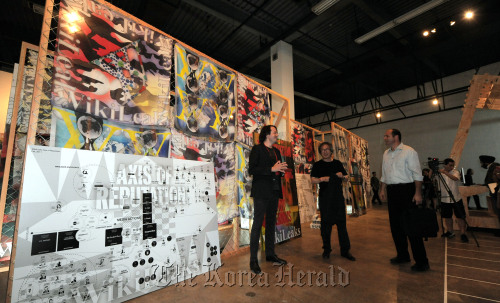Co-director Ai of China unable to attend biennale; Korean director selects Chinese artist’s work for 10 most important exhibits
GWANGJU ― A day may be too short to enjoy everything the 4th Gwangju Design Biennale has to offer.
The nation’s biggest design biennale kicked off its 52-day run on Thursday at the Biennale Exhibition Hall and throughout the Gwangju Metropolitan City with new and unexpected exhibits that proved its growth in quality since the previous season.
The biennale’s attempt to redefine design today, as mirrored in this year’s theme “DOGADOBISANGDO ― Design is Design is Not Design,” an application of Chinese philosopher Lao Tzu’s saying “The way that is the way is not always the way,” is quite successful.
Largely divided into four sections ― “Named,” “Unnamed,” “Communities” and “Gwangju Folly” ― 141 mind-refreshing projects by 135 designers and 73 design firms from 44 countries each offered their own definitions.
“Almost all designers say they are artists but I think design should be design. When we design something, everyone should be able to enjoy and use it easily without any kind of metaphor,” An Jee-yong of MANIFESTO, the design team of the “Bike Hanger,” told The Korea Herald.
 |
Co-director of the 4th Gwangju Design Biennale Seung H-sang (center) talks about the work “Transparent Camouflage” by Metahaven on Thursday. (Ahn Hoon/The Korea Herald) |
The “Bike Hanger,” found in the “Named” section, is a bicycle storage that can be installed on a wall of a building. It is environmentally friendly ― bikers can park and find their bikes by riding on the pedals connected on the installation. After winning awards and being reviewed by the New York Times, MANIFESTO, led by two young South Korean men, jumped to stardom.
“I saw some bike storages in Korea. They built a building to store bikes ― that’s over-design. The reason people ride bikes is because it is sustainable and green but as more people bike, it takes up more space for people to use. Our design is sustainable, using no electricity but only human generator. What we want to do is to please as many people as possible,” said An.
The “Named” section also includes Korean director Bong Joon-ho’s film “The Host” reinterpreted into designs; “The Road of COMME des GARONS” by Japanese designer Rei Kawakubo, which shows the history and concept of the brand; and “Rainbow Fantasy No. 1,” a design work reflecting Korean dancer Ahn Eun-mi’s world.
On the other hand, the name of the designer is less important in the “Unnamed” section, as the artists are often anonymous or even absent. The section presents interesting design trends found in everyday life like campaign posters, police mascots, tattoo designs and Burka designs.
Designers showcasing their works in the “Communities” section see Gwangju as a cluster of different kinds of communities, like those that circle around food or high apartment buildings.
Among the works, “Calls from Gwangju” featuring three telephone booths, is notable. Viewers can either answer phones, if they ring, or call different numbers which connect to recorded voices or sounds of various people in Gwangju like a taxi driver, a nun, a multi-cultural orchestra or an American man who will marry a Gwangju girl next year.
“We practically lived in Gwangju for this and interviewed about a hundred people. We always ‘see’ the city, and hardly ‘listen,’ so we thought of this project,” said Shim Sung-bo, one of the designers.
The final division, “Gwangju Folly,” refers not to a section in the Biennale Exhibition Hall but to a network of 13 small-scale architectural installations throughout the city. World-renowned architects including Juan Herreros from Spain, Florian Beigel from Germany and Nader Tehrani from the U.S. built them, fully mindful the venues’ historical pasts.
“I know that public art is currently considered something that may even damage society. So this project is timely. Follies are public installations that understand the characteristics of the places and add new functions and meaning to them. They will be new cultural infrastructures of the city and make us renew our thoughts on cities,” said Seung H-Sang, co-director of the biennale, at a press conference held prior to the opening ceremony.
Ai Weiwei, the other co-director of the biennale, could not make it to the show although he has been working on it since last year. Currently in Beijing, the Chinese artist and activist is banned from leaving the country for a year following his release on bail in June after 81 days of detention.
His installation work “Field,” a 1.15-meter-tall rectangular installation measuring 7.4 meter by 7.4 meters made with a series of porcelain pipes, however, is displayed near the entrance of the Biennale Exhibition Hall. Seung chose it as one of ten must-see exhibits of the biennale.
The biennale will run through Oct. 23 at the Biennale Exhibition Hall and throughout Gwangju Metropolitan City. For more information, visit www.gb.or.kr.
By Park Min-young (
claire@heraldcorp.com)





![[Herald Interview] 'Trump will use tariffs as first line of defense for American manufacturing'](http://res.heraldm.com/phpwas/restmb_idxmake.php?idx=644&simg=/content/image/2024/11/26/20241126050017_0.jpg)

![[Herald Review] 'Gangnam B-Side' combines social realism with masterful suspense, performance](http://res.heraldm.com/phpwas/restmb_idxmake.php?idx=644&simg=/content/image/2024/11/25/20241125050072_0.jpg)
![[Health and care] Getting cancer young: Why cancer isn’t just an older person’s battle](http://res.heraldm.com/phpwas/restmb_idxmake.php?idx=644&simg=/content/image/2024/11/26/20241126050043_0.jpg)